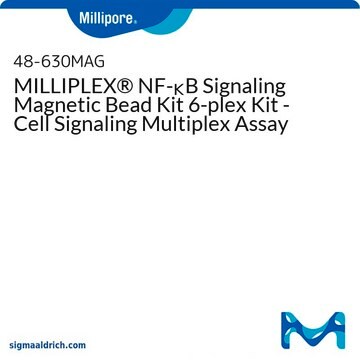43-040
MILLIPLEX MAP Lysis buffer for Multiplexing
Synonym(s):
Buffer for MILLIPLEX, Lysis Buffer for Multiplexing, Multiplex Lysis Buffer
Sign Into View Organizational & Contract Pricing
All Photos(1)
About This Item
UNSPSC Code:
41116012
eCl@ss:
32160405
NACRES:
NA.25
Recommended Products
form
solution
Quality Level
manufacturer/tradename
Milliplex®
technique(s)
multiplexing: suitable
detection method
fluorometric (Luminex xMAP)
Application
Research Category
All
All
This MILLIPLEX MAP Lysis Buffer is a buffer used for multiplex Cell Signaling bead-based kits.
Storage and Stability
stable 1 year at 4°C from date of shipment
Legal Information
MILLIPLEX is a registered trademark of Merck KGaA, Darmstadt, Germany
Disclaimer
Unless otherwise stated in our catalog or other company documentation accompanying the product(s), our products are intended for research use only and are not to be used for any other purpose, which includes but is not limited to, unauthorized commercial
Signal Word
Warning
Hazard Statements
Precautionary Statements
Hazard Classifications
Aquatic Chronic 3 - Eye Irrit. 2
Storage Class Code
12 - Non Combustible Liquids
WGK
WGK 2
Flash Point(F)
Not applicable
Flash Point(C)
Not applicable
Certificates of Analysis (COA)
Search for Certificates of Analysis (COA) by entering the products Lot/Batch Number. Lot and Batch Numbers can be found on a product’s label following the words ‘Lot’ or ‘Batch’.
Already Own This Product?
Find documentation for the products that you have recently purchased in the Document Library.
Rasha Al-Attar et al.
Comparative biochemistry and physiology. Part A, Molecular & integrative physiology, 242, 110653-110653 (2020-01-12)
Naked mole rats (NMRs, Heterocephalus glaber) are among the most hypoxia-tolerant mammals known. They can reduce their metabolic rate (>85%) under severe hypoxia, remain moderately active and recover with no obvious signs of damage. Hence, NMRs are an excellent model
Aakriti Gupta et al.
Comparative biochemistry and physiology. Part B, Biochemistry & molecular biology, 243-244, 110436-110436 (2020-04-05)
The wood frog (Rana sylvatica) is a remarkable species. These frogs can endure prolonged oxygen deprivation as well as dehydration to ~60% of total body water lost and, combining these two abilities, they survive whole body freezing for weeks at
Our team of scientists has experience in all areas of research including Life Science, Material Science, Chemical Synthesis, Chromatography, Analytical and many others.
Contact Technical Service









